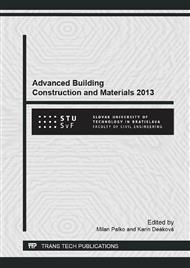p.219
p.225
p.229
p.233
p.237
p.241
p.245
p.255
p.259
Occurrences of Standard Skies and Luminuos Turbidity Factor in Bratislava
Abstract:
Levels of daylighting in nature continually changing and their daily courses are different day to day. Effectiveness of daylight utilisation in buildings depends on exterior luminous conditions resulting from sunny and sunless situations. Generally, prevailing interiors are illuminated by diffuse skylight during year but sunny orientated rooms can be often exposed by direct sunlight. To describe these conditions the occurrence of sky luminance patterns and light attenuation properties of atmosphere expressed e.g. by luminous turbidity factor are needed. This paper presents the comparison and evaluation of occurrences of ISO/CIE General Standard Sky and luminous turbidity factor in two distant years on the base of measured instantaneous global and diffuse horizontal illuminance, global and diffuse horizontal irradiance and zenith luminance taken during 1995 a 2002 at ICA SAS in Bratislava. The different occurrences of luminous situations described by general standard sky types were found. Results of the luminous turbidity factor calculation show that various atmospheric pollutions during sunny situations can be expected.
Info:
Periodical:
Pages:
259-265
Citation:
Online since:
December 2013
Authors:
Price:
Сopyright:
© 2014 Trans Tech Publications Ltd. All Rights Reserved
Share:
Citation:


